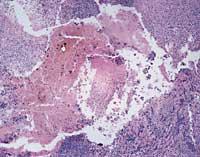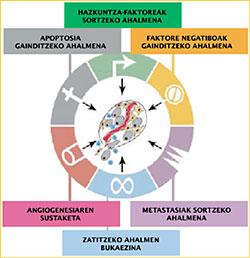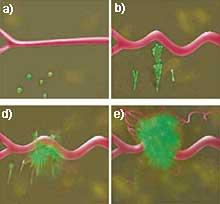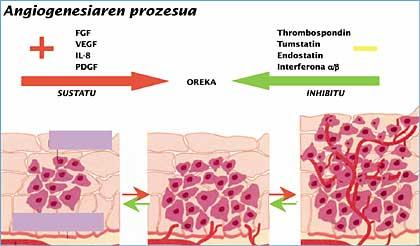Cancer: when the balance of cell society is destroyed

To describe in a nutshell all the factors and processes involved in cancer would be as difficult and heavy as treating the disease itself. However, it can be summarized that cancer occurs when a cell breaks the social attitudes that are legal. Then all of your adjacent cells follow the same rules, such as growth, division, or cell death. Cancer derives all standards to one goal: to foster growth and division and prevent death. Therefore, cancer does everything in its hands to survive and extend the disease to the entire human body.
But what factors influence these postural changes in cells? Cell regulation controls and mechanisms are very complex and thousands of scientists work to resolve and understand them correctly. Some of these mechanisms activate the motor of the cells and others cushion it. Balance gives stability to the cell, tissue and, extrapolating it, our body. And when the cell balance breaks and the cell motors accelerate, problems arise.
In this situation the cells fragment more, grow more and, in addition, their survival is greatly encouraged. You can break the balance for three reasons. On the one hand, because factors are promoted that accelerate the motor of the cells, on the other, because those that act as brakes are reduced and, finally, because the first two occur together.
Researchers have distinguished in six groups the causes of cancer and, in general, the cells must have these six capacities to cause cancer. They must have an inexhaustible separation capacity and produce growth factors that ensure their development. They should also have the ability to be resistant to negative signals and factors that impede cell development. Cells should avoid apoptosis or programmed cell death to make it immortal.

However, all this is not enough to produce the disease. In the millions of cells that separate it is necessary to create new genetic mutations that favor angiogenesis, the formation of new blood vessels and metastasis. It should not be forgotten that the three or four paragraphs, besides being very broad and complex scientific fields, are the field of work of many researchers.
Low risk of cancer
Fortunately, the risk of cancer is very low, among other things because our immune system quickly destroys mutated cells. It should also be noted that all the above-mentioned capabilities are fundamental for the onset and spread of the disease.
For example, in the autopsies of men aged 50 to 70, in almost all cases small cancers have been found in the thyroid gland. However, only 0.1% of the population has developed the disease. The same happens in the autopsies of women aged 40 to 50. Although breast cancer was observed in one third, only 1% developed the disease.
This means that small cancers are asleep in our bodies and that only a small percentage can develop the disease. But why does that happen? According to experts, cancer has not acquired all the necessary capabilities to produce the disease. That is, despite its development, fragmentation and avoidance of apoptosis, if it does not encourage the formation of new blood vessels (angiogenesis), cancer has very little chance of obtaining food and then developing metastases through blood vessels.
Angiogenesis, like five other processes, is regulated by multiple factors. Many of them encourage the formation of blood vessels and many others inhibit it. Once again, rupturing the balance of angiogenesis will add value to harmful cells to cause the disease. However, even though some cells have entered the blood flow, they will still have to get the ability to invade tissues to produce metastases, that is, to spread them to other parts of the body.

According to the latest studies, all these balances are destroyed according to the genetic characteristics of malignant cells and micromedia. Thus, it is easy to understand why each cancer develops at a speed or why in some individuals the disease appears quickly and in others it never appears.
These conclusions have been obtained by the researchers thanks to the particularities they have seen in nature. For example, solid cancer has a very small percentage of people with Down syndrome
Scientists began to look for the causes and saw that in these patients the level of negative regulatory endostatin was much higher than normal. That is, the balance of angiogenesis was displaced to the negative or inhibitory part (difficulty in the formation of new blood vessels). This undoubtedly explained the low incidence of solid cancers.
Taking this case as an example, experts thought that increasing negative regulators in patients would allow them to obtain promising medications. Due to this, currently there are clinical trials underway that analyze the negative regulators of angiogenesis.
In this sense, one of the main objectives of science is to analyze people protected from cancers to know the causes of this protection. In this way, as with Down syndrome, we can find factors or regulators that can become future drugs.
On the other hand, the decoding of the human genome allows us to know the state of the genes of each and, in turn, the risk of cancer. As noted by the prestigious researcher Joan Massagüé and the winner of the Prince of Asturias Award, one day we will have an individual therapy for each type of cancer. People will be able to know which type of cancer is most sensitive and can therefore take appropriate preventive measures.
However, it should be noted that fortunately the cancer journey is long and heavy, and that in most cases our body is able to curb the illegal capabilities of cells.
However, in the development of cancer, a malignant cell may be sufficient to cause the disease. Internal and external genetic factors (combustion, ultraviolet radiation, etc.) are fundamental to maintain or destroy cellular balance.

BIBLIOGRAPHY
- Hanahan, G. and Weinberg, R. A. “The hallmarks of cancer” Cell. 100:57-70 (2000). Folkman, J. and Kalluri, R. “Cancer without disease” Nature. 427:787 (2004). Hynes, R. Or. “Metastatic potential: generic predisposition of the primary tumor rare, metastatic variants-or both” Cell. 113:821-823 (2003).
Buletina
Bidali zure helbide elektronikoa eta jaso asteroko buletina zure sarrera-ontzian











